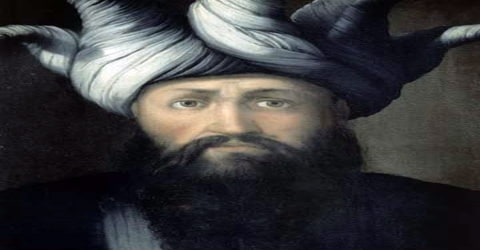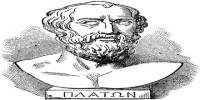Biography of Saladin
Saladin – The first sultan of Egypt and Syria.
Name: An-Nasir Salah ad-Din Yusuf ibn Ayyub
Known as – Salah ad-Din or Saladin
Date of Birth: 1137/38
Place of Birth: Tikrit, Upper Mesopotamia, Abbasid Caliphate
Date of Death: 4 March 1193 (aged 55–56)
Place of Death: Damascus, Syria, Ayyubid Sultanate
Famous As: Sultan Of Egypt
Father: Najm ad-Dīn Ayyūb
Spouse: Ismat ad-Din Khatun, Shamsa
Children: Al-Afdal Ibn Salah Ad-Din, Al-Aziz Uthman, Al-Zahir Ghazi, Ishaq Ibn Ṣalāḥ Al-Dīn
Early Life

Saladin, famous Sultan of Egypt, and founder of the ‘Ayyubid Dynasty’, was born in the year 1137/38, Tikrīt, Mesopotamia. He began his military career with a minor role, assisting his uncle Shirkuh. However, soon he proved his ability and was given charge of more important battles.
His family was of Kurdish descent and adhered to the Sunni sect of Islam. He seems to have been well educated from a young age, and while he was more of a scholar than a warrior, he was entered into the military under his uncle’s tutelage. It was in this position that he saw his first battles of the Crusades, leading troops against Crusaders near Giza, in Egypt. Saladin would later be credited as the architect of the Islamic victory in this battle.
After Shirkuh’s death, he took over as the vizier of the ‘Fatimid Caliphate’ and waged several wars in this capacity, gradually increasing his power in the Caliphate. He was in particular, effective against the English Crusaders, defeating them in almost every war fought. He reached the height of his power when al-Adid, Caliph of the ‘Fatimid Dynasty’ died, and this shrewd leader formed an alliance with rival ‘Abbasids’. Also, when his mentor, Nur ad-Din died, he went on to conquer the whole of Syria, attacking each city one by one.
He was originally sent to Fatimid Egypt in 1164 accompanying his uncle Shirkuh, a general of the Zengid army, on orders of their lord Nur ad-Din, an atabeg of the Seljuks, to consolidate Shawar amid his ongoing power struggle for vizier to the teenage Fatimid caliph al-Adid. With Shawar reinstated as vizier, he engaged in a power struggle with Shirkuh, which saw the former realigning himself with Crusader king Amalric. Saladin climbed the ranks of the Fatimid government by virtue of his military successes against Crusader assaults against its territory and his personal closeness to al-Adid. With Shawar assassinated in 1169 and Shirkuh’s natural death later that year, al-Adid appointed Saladin vizier, a rare nomination of a Sunni Muslim to such an important position in the Isma’ili Shia caliphate. During his tenure as vizier, Saladin began to undermine the Fatimid establishment and, following al-Adid’s death in 1171, he abolished the Fatimid Caliphate and realigned the country’s allegiance with the Sunni, Baghdad-based Abbasid Caliphate.
His major victory came against King Richard the Lionheart during the ‘Battle of Hatin’, when Palestine once again became a part of a Muslim dynasty, after eighty-eight years. When he died, he left all his possessions to the poor citizens of his dynasty, leaving nothing behind to give him a decent burial. Even after his death, he is held in high regard, not just in Muslim countries, but also by countries in the west, where people remember him for his generosity and kindness.
Saladin died in Damascus in 1193, has given away much of his personal wealth to his subjects. He is buried in a mausoleum adjacent to the Umayyad Mosque. Saladin has become a prominent figure in Muslim, Arab, Turkish and Kurdish culture, and he has often been described as being the most famous Kurd in history.
Childhood, Family and Educational Life
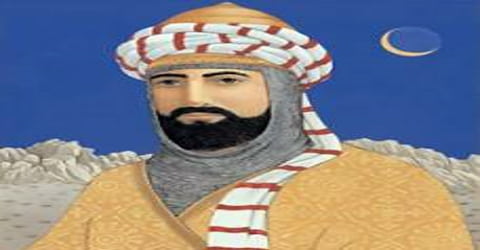
Saladin, Arabic in full Ṣalāḥ al-Dīn Yūsuf ibn Ayyūb (“Righteousness of the Faith, Joseph, Son of Job”), also called al-Malik al-Nāṣir Ṣalāḥ al-Dīn Yūsuf I, was born to Najm ad-Din Ayyub and his wife, in the year 1138, at Tikrit, Iraq. The following year, the family traveled to the city of Mosul and was given shelter by the ruler Imad ad-Din Zengi.
On the night of his birth, his father, Najm al-Dīn Ayyūb, gathered his family and moved to Aleppo, there entering the service of ʿImad al-Dīn Zangī ibn Aq Sonqur, the powerful Turkish governor in northern Syria. Growing up in Baʿlbek and Damascus, Saladin was apparently an undistinguished youth, with a greater taste for religious studies than military training.
Saladin, who now lived in Damascus, was reported to have a particular fondness for the city, but information on his early childhood is scarce. About education, Saladin wrote, “children are brought up in the way in which their elders were brought up.” According to his biographers, Anne-Marie Eddé and al-Wahrani, Saladin was able to answer questions on Euclid, the Almagest, arithmetic, and law, but this was an academic ideal and it was study of the Qur’an and the “sciences of religion” that linked him to his contemporaries. Several sources claim that during his studies he was more interested in religion than joining the military. Another factor which may have affected his interest in religion was that, during the First Crusade, Jerusalem was taken by the Christians. In addition to Islam, Saladin had a knowledge of the genealogies, biographies, and histories of the Arabs, as well as the bloodlines of Arabian horses. More significantly, he knew the Hamasah of Abu Tammam by heart. He spoke Kurdish and Arabic.
When Imad ad-Din Zengi died, his son, Nur ad-Din took over the throne, and Saladin’s uncle, Asad al-Din Shirkuh served as a commander of the ‘Zengid’ army. It was under uncle Shirkuh’s supervision, that the young boy learnt military tactics and strategies.
Shawar, the vizier of the ‘Fatimid Caliphate’ approached Nur ad-Din to help him in his struggle against rival leader Dirgham. Nur ad-Din obliged, and sent an army led by Shirkuh, to assist Shawar in the fight. Shirkuh and Shawar were accompanied by Saladin, but the latter did not have much of a role to play in the minor battle.
Personal Life
His personal name was “Yusuf”; “Salah ad-Din” is a laqab, an honorific epithet, meaning “Righteousness of the Faith.”
Not much is known of Saladin’s wives or slave-women. He married Ismat al-Din Khatun, the widow of Nur al-Din Zengi, in 1176. She did not have children. One of his wives, Shamsah, is buried with her son al-Aziz in the tomb of al-Shafi’i.
Career and Works

In 1164, the ‘Zengid Dynasty’ waged a war against the Crusader-Egyptian army that had attacked and captured the city of Bilbais. The army of the ‘Zengids’ was partly led by Shirkuh, while the other two sections were led by Saladin, and the Kurds, respectively. In this war, the young general played a significant role by defeating Hugh of Caesarea, the leader of the rival army.
After the sacking of Bilbais, the Crusader-Egyptian force and Shirkuh’s army were to engage in a battle on the desert border of the River Nile, just west of Giza. Saladin played a major role, commanding the right wing of the Zengid army, while a force of Kurds commanded the left, and Shirkuh was stationed in the center. Muslim sources at the time, however, put Saladin in the “baggage of the center” with orders to lure the enemy into a trap by staging a feigned retreat. The Crusader forces enjoyed early success against Shirkuh’s troops, but the terrain was too steep and sandy for their horses, and commander Hugh of Caesarea was captured while attacking Saladin’s unit. After scattered fighting in little valleys to the south of the main position, the Zengid central force returned to the offensive; Saladin joined in from the rear.
The battle ended in a Zengid victory, and Saladin is credited with having helped Shirkuh in one of the “most remarkable victories in recorded history”, according to Ibn al-Athir, although more of Shirkuh’s men were killed and the battle is considered by most sources as not a total victory. Saladin and Shirkuh moved towards Alexandria where they were welcomed, given money, arms and provided a base. Faced by a superior Crusader-Egyptian force attempting to besiege the city, Shirkuh split his army. He and the bulk of his force withdrew from Alexandria, while Saladin was left with the task of guarding the city.
By roughly 1169, Saladin had gained enough recognition and respect to catch the attention of the caliphs (Islamic rulers) of the Fatimid Caliphate in Egypt. Saladin rose quickly up the governmental ranks and was eventually named the Vizier of Egypt. This was an interesting move since the Fatimid rulers were Shia Muslims, and Saladin was Sunni. The two sects didn’t often share power. Saladin, it seems, was not about to waste the opportunity. He worked his way further into the Fatimid government, and when the caliph died in 1171, he seized control.
Saladin’s position was further enhanced when, in 1171, he abolished the weak and unpopular Shīʿite Fāṭimid caliphate, proclaiming a return to Sunni Islam in Egypt. Although he remained for a time theoretically a vassal of Nūr al-Dīn, that relationship ended with the Syrian emir’s death in 1174. Using his rich agricultural possessions in Egypt as a financial base, Saladin soon moved into Syria with a small but strictly disciplined army to claim the regency on behalf of the young son of his former suzerain. Soon, however, he abandoned this claim, and from 1174 until 1186 he zealously pursued a goal of uniting, under his own standard, all the Muslim territories of Syria, northern Mesopotamia, Palestine, and Egypt. This he accomplished by skillful diplomacy backed when necessary by the swift and resolute use of military force. Gradually his reputation grew as a generous and virtuous but firm ruler, devoid of pretense, licentiousness, and cruelty. In contrast to the bitter dissension and intense rivalry that had up to then hampered the Muslims in their resistance to the Crusaders, Saladin’s singleness of purpose induced them to rearm both physically and spiritually.
By 1170, the young vizier had consolidated his power over most of Egypt, with support from Nur ad-Din, and the Caliph of the ‘Abbasid Dynasty’, al-Mustanjid. One of his major battles during this time was the war waged against the King of Jerusalem, Amalric, in a bid to capture the cities of Darum and Gaza. When al-Adid died in 1171, it was Saladin who took over as ruler of the ‘Fatimid Dynasty’, and the latter formed an association with the ‘Abbasid Caliphate’.
In the early summer of 1174, Nur ad-Din was mustering an army, sending summons to Mosul, Diyar Bakr, and the Jazira in an apparent preparation of an attack against Saladin’s Egypt. The Ayyubids held a council upon the revelation of these preparations to discuss the possible threat and Saladin collected his own troops outside Cairo. On 15 May, Nur ad-Din died after falling ill the previous week and his power was handed to his eleven-year-old son as-Salih Ismail al-Malik. His death left Saladin with political independence and in a letter to as-Salih, he promised to “act as a sword” against his enemies and referred to the death of his father as an “earthquake shock”.
By 1175, the ruler had captured the cities of Homs and Hama, which resulted in other ‘Zengid’ chiefs waging wars against him. Once the ‘Zengids’ were vanquished, al-Mustadi, the caliph of the ‘Abbasid Dynasty’ declared the former as the “Sultan of Egypt and Syria”.

After leaving the an-Nusayriyah Mountains, Saladin returned to Damascus and had his Syrian soldiers return home. He left Turan Shah in command of Syria and left for Egypt with only his personal followers, reaching Cairo on 22 September. Having been absent roughly two years, he had much to organize and supervise in Egypt, namely fortifying and reconstructing Cairo. The city walls were repaired and their extensions laid out, while the construction of the Cairo Citadel was commenced. The 280 feet (85 m) deep Bir Yusuf (“Joseph’s Well”) was built on Saladin’s orders. The chief public work he commissioned outside of Cairo was the large bridge at Giza, which was intended to form an outwork of defense against a potential Moorish invasion.
As the new Sultan, Saladin conquered several other areas, including the Upper Mesopotamian area known as Jazira. In 1177, he came back to Egypt, to look after royal matters there. The same year, with an army of 26,000 warriors, he launched an attack on Palestine.
In the spring of 1178, Saladin was encamped under the walls of Homs, and a few skirmishes occurred between his generals and the Crusader army. His forces in Hama won a victory over their enemy and brought the spoils, together with many prisoners of war, to Saladin who ordered the captives to be beheaded for “plundering and laying waste the lands of the Faithful”. He spent the rest of the year in Syria without a confrontation with his enemies.
Saladin had been a young man during the Second Crusade, when European knights had already managed to seize control of Jerusalem and established it as a European kingdom. As a Sultan, he was determined to take the Holy Land back. After a series of wars against Crusader armies, the armies met at the Battle of Hattin in 1187 to fight for Jerusalem itself. Saladin didn’t just win this battle; he destroyed the Crusader army. It was one of the most significant turning points in the history of the Crusades, and Jerusalem was back under Islamic control.
Despite his reputation as a fierce defender of Islam, Saladin was also a scholar and wise politician. He treated Christians and Jews in Jerusalem with a much higher degree of kindness than Crusaders had shown Muslims when they first took the city.
In the summer of 1179, King Baldwin had set up an outpost on the road to Damascus and aimed to fortify a passage over the Jordan River, known as Jacob’s Ford, that commanded the approach to the Banias plain (the plain was divided by the Muslims and the Christians). Saladin had offered 100,000 gold pieces to Baldwin to abandon the project, which was particularly offensive to the Muslims, but to no avail. He then resolved to destroy the fortress, called Chastellet and manned by the Templars, moving his headquarters to Banias. As the Crusaders hurried down to attack the Muslim forces, they fell into disorder, with the infantry falling behind. Despite early success, they pursued the Muslims far enough to become scattered, and Saladin took advantage by rallying his troops and charged at the Crusaders. The engagement ended in a decisive Ayyubid victory, and many high-ranking knights were captured. Saladin then moved to besiege the fortress, which fell on 30 August 1179.
During 1182-84, he attacked the cities of Sinjar, Beisan, Beirut, as well as Kerak, capturing them easily with his forces, and moved on to seize Aleppo. With the conquest of Aleppo, the Sultan’s hold over Syria was reinforced. His attack on ‘Zengid’-ruled Mosul was however difficult to pull off, because of the opponent’s strong allies.
In the summer of 1181, Saladin’s former palace administrator Qara-Qush led a force to arrest Majd al-Din—a former deputy of Turan-Shah in the Yemeni town of Zabid—while he was entertaining Imad ad-Din at his estate in Cairo. Saladin’s intimates accused Majd al-Din of misappropriating the revenues of Zabid, but Saladin himself believed there was no evidence to back the allegations. He had Majd al-Din released in return for a payment of 80,000 dinars. In addition, other sums were to be paid to Saladin’s brothers al-Adil and Taj al-Muluk Buri. The controversial detainment of Majd al-Din was a part of the larger discontent associated with the aftermath of Turan-Shah’s departure from Yemen. Although his deputies continued to send him revenues from the province, centralized authority was lacking and an internal quarrel arose between Izz al-Din Uthman of Aden and Hittan of Zabid. Saladin wrote in a letter to al-Adil:
“this Yemen is a treasure house … We conquered it, but up to this day we have had no return and no advantage from it. There have been only innumerable expenses, the sending out of troops … and expectations which did not produce what was hoped for in the end.”
In 1186, Saladin had to stall his attempts of conquering Mosul when he became sick, and a peace agreement was signed between the ‘Ayyubids’ and the ‘Zengids’. The following year, the ‘Ayyubids’ fought the ‘Battle of Hattin’ against the Crusaders. This historic battle waged in 1187 resulted in the victory of Saladin, eighty-eight years after the Crusaders had captured Palestine from Muslim rulers.
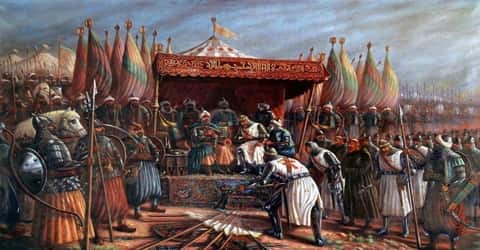
(Saladin and Guy of Lusignan after Battle of Hattin)
Saladin also succeeded in turning the military balance of power in his favor more by uniting and disciplining a great number of unruly forces than by employing new or improved military techniques. When at last, in 1187, he was able to throw his full strength into the struggle with the Latin Crusader kingdoms, his armies were their equals. On July 4, 1187, aided by his own military good sense and by a phenomenal lack of it on the part of his enemy, Saladin trapped and destroyed in one blow an exhausted and thirst-crazed army of Crusaders at Ḥaṭṭīn, near Tiberias in northern Palestine. So great were the losses in the ranks of the Crusaders in this one battle that the Muslims were quickly able to overrun nearly the entire kingdom of Jerusalem. Acre, Toron, Beirut, Sidon, Nazareth, Caesarea, Nāblus, Jaffa (Yafo), and Ascalon (Ashqelon) fell within three months. But Saladin’s crowning achievement and the most disastrous blow to the whole Crusading movement came on October 2, 1187, when the city of Jerusalem, holy to both Muslim and Christian alike, surrendered to Saladin’s army after 88 years in the hands of the Franks. Saladin planned to avenge the slaughter of Muslims in Jerusalem in 1099 by killing all Christians in the city, but he agreed to let them purchase their freedom provided that the Christian defenders left the Muslim inhabitants unmolested.
Tyre, on the coast of modern-day Lebanon, was the last major Crusader city that was not captured by Muslim forces. Strategically, it would have made more sense for Saladin to capture Tyre before Jerusalem; Saladin, however, chose to pursue Jerusalem first because of the importance of the city to Islam. Tyre was commanded by Conrad of Montferrat, who strengthened its defenses and withstood two sieges by Saladin. In 1188, at Tortosa, Saladin released Guy of Lusignan and returned him to his wife, Queen Sibylla of Jerusalem. They went first to Tripoli, then to Antioch. In 1189, they sought to reclaim Tyre for their kingdom but were refused admission by Conrad, who did not recognize Guy as king. Guy then set about besieging Acre.
In 1189, King Richard the Lionheart attempted for the third time, to conquer the Kingdom of Jerusalem, where they began with an attack on the Israeli city of Acre.
Hattin and the fall of Jerusalem prompted the Third Crusade (1189–1192), financed in England by a special “Saladin tithe”. Richard the Lionheart, King of England led Guy’s siege of Acre, conquered the city and executed 3,000 Muslim prisoners, including women and children. Bahā’ ad-Dīn wrote:
The motives of this massacre are differently told; according to some, the captives were slain by way of reprisal for the death of those Christians whom the Musulmans had slain. Others again say that the king of England, on deciding to attempt the conquest of Ascalon, thought it unwise to leave so many prisoners in the town after his departure. God alone knows what the real reason was.
On September 7, 1191, the army of King Richard and that of the ‘Ayyubid Dynasty’ faced each other at the ‘Battle of Arsuf’. The latter was forced to flee since their army was weaker than that of the Crusaders. The ‘Ayyubids’ however, retaliated the next day, thwarting every attempt made by King Richard to recapture Jerusalem.
The Crusade itself was long and exhausting, despite the obvious, though at times impulsive, military genius of Richard I (the Lion-Heart). Therein lies the greatest but often unrecognized achievement of Saladin. With tired and unwilling feudal levies, committed to fight only a limited season each year, his indomitable will enabled him to fight the greatest champions of Christendom to a draw. The Crusaders retained little more than a precarious foothold on the Levantine coast, and when King Richard left the Middle East, in October 1192, the battle was over. Saladin withdrew to his capital at Damascus.
After Richard reoccupied Jaffa and restored its fortifications, he and Saladin again discussed terms. At last Richard agreed to demolish the fortifications of Ascalon, while Saladin agreed to recognize Crusader control of the Palestinian coast from Tyre to Jaffa. The Christians would be allowed to travel as unarmed pilgrims to Jerusalem, and Saladin’s kingdom would be at peace with the Crusader states for the following three years.
While his relatives were already scrambling for pieces of the empire, his friends found that the most powerful and most generous ruler in the Muslim world had not left enough money to pay for his grave. Saladin’s family continued to rule over Egypt and neighboring lands as the Ayyūbid dynasty, which succumbed to the Mamlūk dynasty in 1250.
Death and Legacy
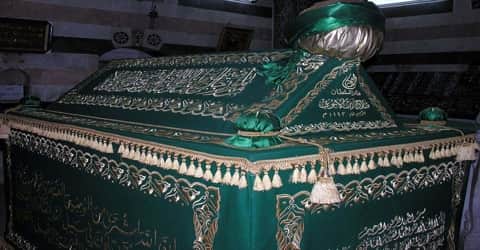
(Saladin’s tomb, Damascus, Syria)
Saladin died of a fever on 4 March 1193, at Damascus, not long after King Richard’s departure. In Saladin’s possession at the time of his death were one piece of gold and forty pieces of silver. He had given away his great wealth to his poor subjects, leaving nothing to pay for his funeral. He was buried in a mausoleum in the garden outside the Umayyad Mosque in Damascus, Syria.
A province in Iraq is named Salah ad Din Governorate, after the great Sultan of Egypt. Kudistan’s city of Arbil, houses the ‘Salahaddin University’, and a community called ‘Masif Salahaddin’, both named as a tribute to this ruler.
The coat of arms of Egypt is known as the ‘Eagle of Saladin’, and it represents the unity between Arab states.
Seven centuries later, Emperor Wilhelm II of Germany donated a new marble sarcophagus to the mausoleum. However, the original sarcophagus was not replaced; instead, the mausoleum, which is open to visitors, now has two sarcophagi: the marble one placed on the side and the original wooden one, which covers Saladin’s tomb. (Muslims are buried in a simple shroud, so if there are any sarcophagi present, they are usually used for covering the top of the Islamic burials.)
Information Source:
